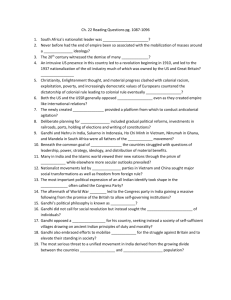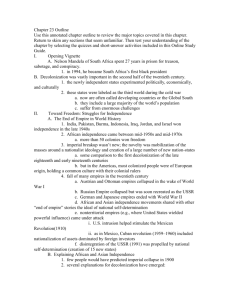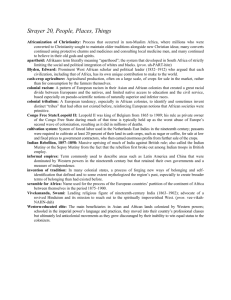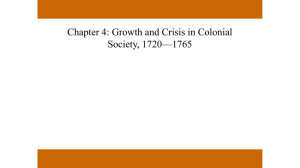Chapter 23
advertisement
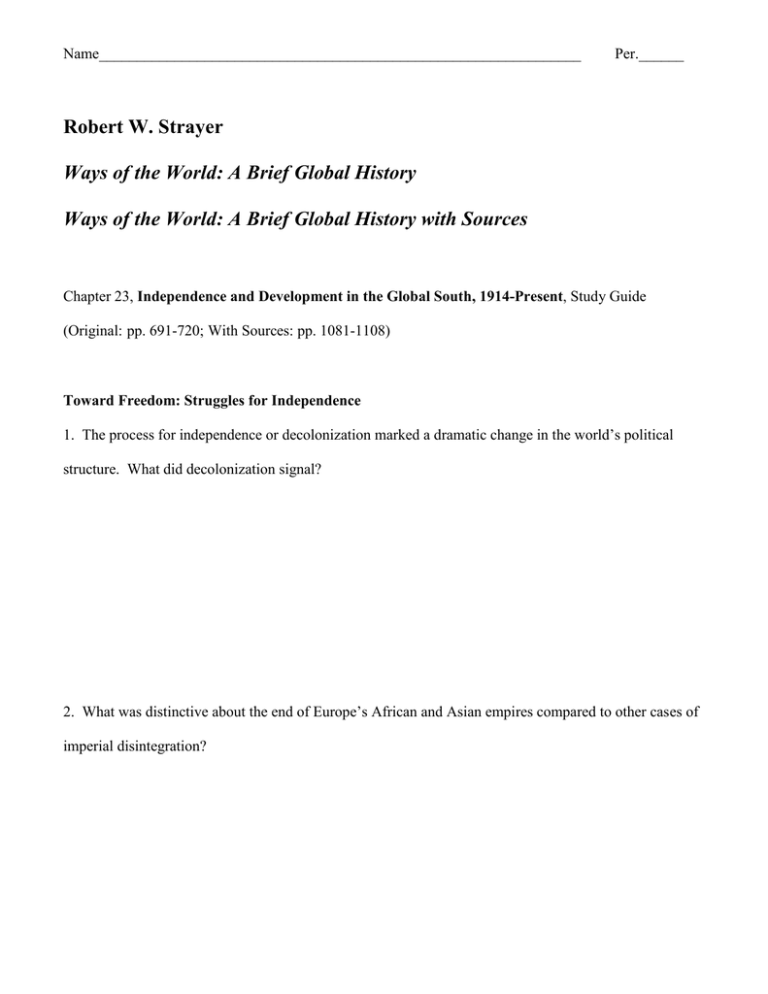
Name________________________________________________________________ Per.______ Robert W. Strayer Ways of the World: A Brief Global History Ways of the World: A Brief Global History with Sources Chapter 23, Independence and Development in the Global South, 1914-Present, Study Guide (Original: pp. 691-720; With Sources: pp. 1081-1108) Toward Freedom: Struggles for Independence 1. The process for independence or decolonization marked a dramatic change in the world’s political structure. What did decolonization signal? 2. What was distinctive about the end of Europe’s African and Asian empires compared to other cases of imperial disintegration? 3. What international circumstances and social changes contributed to the end of European colonial empires? 4. What obstacles confronted the leaders of movements for independence? Comparing Freedom Struggles 5. What were the initial aims of the Indian National Congress (INC 1885)? 6. What was Gandhi’s role in India’s struggle for independence? 7. What conflicts and differences divided India’s nationalist movement? 8. What did Gandhi and the INC finally agree to do amid the mounting violence? 9. Why did white rule last almost fifty years longer in South Africa than it did in India (1994 versus 1947)? 10. Who were the “Boers” or “Afrikaners?” 11. Why did the South Africans feel threatened by a black majority rule? (Economically? Racially?) 12. What forms of opposition arose to contest the injustices of South African life/ 13. How did Nelson Mandela lead the African National Congress (ANC)? 14. After Mandela’s imprisonment, what direction did the South African freedom struggle take? 15. What was the international response to apartheid? 16. How was the South African nationalist movement similar and different than India’s? Experiments with Freedom 17. What was the fate of many of the political parties that had led the movements for independence in Africa after independence was achieved? 18. Why was Africa’s experience with political democracy so different from that of India? 19. What accounts for the ups and downs of political democracy in postcolonial Africa? Give at least three examples. 20. In general, which class benefited the most from independence in Africa? 21. What obstacles impeded the economic development of third-world countries? 22. Which countries, in general, have had the strongest record of economic growth? 23. Discuss Ataturk’s reforms in a Turkish society. 24. What were the visible symbols of Ataturk’s revolutionary program? 25. In what other ways did women gain new legal rights in Turkey? 26. What effect did the Westernizing influences under the Shah of Iran have on the nation of Iran? 27. How did the Ayatollah Khomeini become the center of a growing movement demanding the shah’s removal? 28. What effect did his leadership have on Iran? Explain the significance of each of the following: Indian National Congress— Mohandas Gandhi— Muhammad Ali Jinnah— African National Congress— Kemal Ataturk— Ayatollah Khomeini— Chapter 23 Study Guide Answer Key 1. The process for independence or decolonization marked a dramatic change in the world’s political structure. What did decolonization signal? Decolonization marked a dramatic change in the world’s political architecture, as nation-states triumphed over the empires that had structured much of African and Asian life in the nineteenth and early twentieth centuries. It mobilized millions of people, thrusting them into political activity and sometimes into violence and warfare. Decolonization signaled the declining legitimacy of both empire and race as credible bases for political or social life. It promised not only national freedom but also personal dignity, abundance, and opportunity. (Original: p. 692; With Sources: p. 1082) 2. What was distinctive about the end of Europe’s African and Asian empires compared to other cases of imperial disintegration? Never before had the end of empire been so associated with the mobilization of the masses around a nationalist ideology; nor had these earlier cases generated a plethora of nation-states, each claiming an equal place in a world of nation-states. (Original: p. 692; With Sources: p. 1082) 3. What international circumstances and social changes contributed to the end of European colonial empires? At the international level, the world wars weakened Europe, while discrediting any sense of European moral superiority. Both the United States and the Soviet Union, the new global superpowers, generally opposed the older European colonial empires. The United Nations provided a prestigious platform from which to conduct anti-colonial agitation. By the early twentieth century in Asia and the mid-twentieth century in Africa, a second or third generation of Western-educated elites, largely male, had arisen throughout the colonial world. These young men were very familiar with European culture, were deeply aware of the gap between its values and its practices, no longer viewed colonial rule as a vehicle for their peoples’ progress as their fathers had, and increasingly insisted on independence now. Growing numbers of ordinary people also were receptive to this message. (Original: p. 694-695; With Sources: pp. 10841085) 4. What obstacles confronted the leaders of movements for independence? Leaders had to organize political parties, recruit members, plot strategy, develop an ideology, and negotiate both with one another and with the colonial power to secure the transition to independence. In some regions—particularly settler-dominated colonies and Portuguese territories—leaders also directed military operations and administered liberated areas. Beneath the common goal of independence, anti-colonial groups struggled with one another over questions of leadership, power, strategy, ideology, and the distribution of material benefits. (Original: p. 695-696; With Sources: pp. 1085-1086) 5. What were the initial aims of the Indian National Congress (INC 1885)? Initially, its well-educated members did not seek to overthrow British rule; rather they hoped to gain greater inclusion within the political, military, and business life of British India. From such positions of influence, they argued, they could better protect the interests of India than could their foreign-born rulers. (Original: p. 697; With Sources: p. 1087) 6. What was Gandhi’s role in India’s struggle for independence? His emerging political philosophy was an active and confrontational, though non-violent, approach to political action. Between the 1920s and 1930s, he became a leader in the Indian National Congress and transformed it into a mass organization. (Original: p. 697; With Sources: p. 1088) 7. What conflicts and differences divided India’s nationalist movement? Gandhi rejected modern industrialization, but his chief lieutenant, Nehru, supported it. Not all nationalists accepted Gandhi’s non-violent approach nor his inclusive definition of India consisting of both Hindus and Muslims. Some saw efforts to improve the position of women or untouchables as a distraction form the chief task of gaining independence from Britain. A divisive issue was whether to participate in British-sponsored legislative bodies without complete independence. The Muslim League’s founder, Ali Jinnah, argued that those parts of India that had a Muslim majority should have a separate political status. (Original: p. 699; With Sources: p. 1089) 8. What did Gandhi and the INC finally agree to do amid the mounting violence? It partitioned India into two parts: one Muslim and one Hindu. Muslim Pakistan was divided into two wings 1, 000 miles apart and India was a mostly secular Hindu state. (Original: p. 699; With Sources: pp. 1089-1090) 9. Why did white rule last almost fifty years longer in South Africa than it did in India (1994 versus 1947)? South Africa’s independence had been granted to a government wholly controlled by a white settler minority, which represented less than 20% of the total population; the country’s black majority had no political rights whatsoever within the central state. Therefore, Black South Africans’ struggle was against this internal opponent rather than against a distant colonial authority, as in India. (Original: p. 701; With Sources: pp. 1090-1091) 10. Who were the “Boers” or “Afrikaners?” The politically dominant section of the white community, known as Boers or Afrikaners, was descended from the early Dutch settlers, who had arrived in the mid-seventeenth century. The term “Afrikaner” reflected their image of themselves as “white Africans,” permanent residents of the continent rather than colonial intruders. They had unsuccessfully sought independence from a British-ruled South Africa in a bitter struggle (the Boer War, 1899-1902), and a sense of difference and antagonism lingered. (Original: p. 701; With Sources: p. 1091) 11. Why did the South Africans feel threatened by a black majority rule? (Economically? Racially?) Despite a certain hostility between white South Africans of British and Afrikaner background, both felt their way of life and standard of living were jeopardized by any move toward a black majority rule. Unlike a predominantly agrarian India, South Africa had developed a mature industrial economy, based initially in gold and diamond mining, but by midcentury it included secondary industries such as steel, chemicals, automobile manufacturing, rubber processing, and heavy engineering. Almost all black Africans were involved in this complex modern economy, working in urban industries or mines, providing labor for white-owned farms, or receiving payments from relatives who did. The extreme dependence of most Africans on the white-controlled economy rendered individuals highly vulnerable to repressive action, but collectively the threat to withdraw their essential labor also gave them a powerful weapon. The policy of apartheid, which attempted to separate blacks from whites in every conceivable way while retaining their labor power in the white-controlled economy, was expressed through rigid “pass laws.” These laws monitored and tried to control the movement of Africans into the cities, where they were subjected to extreme forms of social segregation. Even though racism was present in colonial India, nothing of this magnitude developed there. (Original: p. 701; With Sources: p. 1091) 12. What forms of opposition arose to contest the injustices of South African life? There were rural rebellions, urban strikes, and independent churches to fight against the injustices. (Original: p. 701; With Sources: p. 1091) 13. How did Nelson Mandela lead the African National Congress (ANC)? Mandela broadened its base of support and launched non-violent civil disobedience—boycotts, strikes, demonstrations, and the burning of the hated passes that all Africans were required to carry. (Original: p. 702; With Sources: p. 1092) 14. After Mandela’s imprisonment, what direction did the South African freedom struggle take? Its major political parties were now illegal. Underground nationalist leaders turned to armed struggled, authorizing selected acts of sabotage and assassination, while preparing for guerilla warfare in camps outside the country. Student groups were part of the Black Consciousness movement, an effort to foster pride, unity, and political awareness among the country’s African majority. An uprising in Soweto ended with hundreds of people killed. Urban violence spread and the radicalization of urban young people had forced the government to declare a state of emergency. (Original: p. 702; With Sources: p. 1092) 15. What was the international response to apartheid? South Africa faced exclusion from most international sporting events, including the Olympics; the refusal of many artists and entertainers to perform in South Africa; economic boycotts; and the withdrawal of private investment funds. This isolated South Africa form a Western world in which its white rulers claimed membership. (Original: p. 703; With Sources: p. 1093) 16. How was the South African nationalist movement similar and different than India’s? As in India, the South African national movement that finally won freedom was divided and conflicted. Unlike India, though, these divisions didn’t occur along religious lines. Rather it was race, ethnicity, and ideology that generated dissension and sometime violence. (Original: p. 703; With Sources: p. 1094) 17. What was the fate of many of the political parties that had led the movements for independence in Africa after independence was achieved? Many of the apparently popular political parties that had led the struggle for independence lost mass support and were swept away by military coups. Other states evolved into one-party systems, sometimes highly authoritarian and bureaucratic and sometimes more open and democratic. Still others degenerated into personal tyrannies or dictatorships. Freedom from colonial rule certainly did not automatically generate the internal political freedoms associated with democracy. (Original: p. 706; With Sources: pp. 1095-1096) 18. Why was Africa’s experience with political democracy so different from that of India? The struggle for independence in India had been a far more prolonged affair, thus providing time for an Indian political leadership to sort itself out. Britain began to hand over power in India in a gradual way well before complete independence was granted. Because of these factors, a far larger number of Indians had useful administrative or technical skills than was the case in Africa. Unlike most African countries, the nationalist movement in India was embodied in a single national party, the INC, whose leadership was committed to democratic practice. The partition of India at independence eliminated a major source of internal discord. Indian statehood could be built on cultural and political traditions that were far more deeply rooted than in most African states. (Original: p. 707; With Sources: p. 1096) 19. What accounts for the ups and downs of political democracy in postcolonial Africa? Give at least three examples. Some have argued that Africans weren’t ready for democracy or that they lacked an educated electorate, a middle class, or perhaps a thoroughly capitalist economy. Others suggested that Africa’s traditional culture, based on communal rather than individualistic values and concerns to achieve consensus rather than majority rule, was not compatible with the competitiveness of party politics. Also, Western-style democracy was simply inadequate for the tasks of development confronting the new states. Creating national unity was certainly more difficult when competing political parties identified primarily with particular ethnic or “tribal” groups. (Original: p. 707-708; With Sources: pp. 1096-1097) 20. In general, which class benefited the most from independence in Africa? Those who benefited most from independence were not large landowners, for most African societies simply did not have an established class whose wealth was based in landed estates. Rather they were members of the relatively well-educated elite who had found high-paying jobs in the growing bureaucracies of the newly independent states. (Original: p.708; With Sources: p. 1097) 21. What obstacles impeded the economic development of third-world countries? societies divided by class, religion, gender and ethnicity independent states that had low literacy rates, few people with managerial experience, a weak private economy, and transportation systems oriented to export rather than national integration Developing countries had little leverage in negotiations with the wealthy nations of the Global North and their immense transnational corporations. It was hard for leaders of developing countries to know what strategies to pursue. (Original: p. 710-711; With Sources: pp. 1098-1099) 22. Which countries, in general, have had the strongest record of economic growth? East Asian countries in general have had the strongest record of economic growth. South Korea, Taiwan, Singapore, and Hong Kong were dubbed “newly industrialized countries,” and China boasted the most rapid economic growth in the world by the end of the 20th century, replacing Japan as the world’s secondlargest economy. (Original: p. 714; With Sources: p. 1102) 23. Discuss Ataturk’s reforms in a Turkish society. Seeking far more than national independence, Ataturk wanted to create a thoroughly modern and Western Turkish society and viewed many traditional Islamic institutions, beliefs, and practices as obstacles to that goal. Within a few years, the caliphate had been officially ended, Sufi orders disbanded, religious courts abolished, and the sharia replaced by Swiss legal codes. Public education was completely secularized, and the Latin alphabet replaced the Arabic script for writing the Turkish language. Religious leaders (the ulama) were brought more firmly under state control. In 1932, the government even ordered that the call to prayer should be made in Turkish rather than Arabic, although this reform was later abandoned. Almost everything that had made Islam an official part of Ottoman public life was dismantled. In Ataturk’s view, Islam should become a modernized personal religion, available to the individual citizens of a secular Turkish state, relegating it to the sphere of private life. (Original: p. 715-716; With Sources: pp. 1103-1105) 24. What were the visible symbols of Ataturk’s revolutionary program? Turkish men were ordered to abandon the traditional headdress known as the fez and to wear brimmed hats. Women did not have to wear the traditional veil (although it was not forbidden) and many elite women abandoned it. (Original: p. 716; With Sources: p. 1104) 25. In what other ways did women gain new legal rights in Turkey? Polygamy was abolished, as was a husband’s right to renounce his wife or wives. Under the Europeanstyle legal codes, women achieved equal rights to divorce, child custody, inheritance, and education. By the mid-1930s, they had been granted the right to vote in national elections, a full decade before French women gained that right. (Original: p. 716; With Sources: p. 1105) 26. What effect did the Westernizing influences under the Shah of Iran have on the nation of Iran? Some Iranians resented Shah Muhammad Reza Pahlavi’s close relationship with the Americans and the British as well as the heavy-handed brutality of his secret police. His land reform programs had alienated landowners and upset traditional village life. Small merchants, shopkeepers, and artisans were threatened by modern stores, large government agencies, and imported foreign goods. Rural migrants to the rapidly growing cities, especially Tehran, lived an insecure life and were forced to cope with inflation, unemployment, and falling standards of living. Furthermore, the shah had provoked the Shia religious establishment by attempting to redistribute religious lands; by initiating reforms that offered women greater rights and a literacy program that threatened to replace religious schools; and by permitting the growth of Western political, economic, and cultural influences in the country. His decision to replace the Islamic calendar with one derived from Persian imperial history further alienated his subjects, as did the building of a Hyatt Hotel, which served foreign wines and liquors, near a religious sanctuary in the city of Meshed. (p. 717) 27. How did the Ayatollah Khomeini become the center of a growing movement demanding the shah’s removal? As an exile in Paris in the late 1970s, his taped messages were distributed through a network of local religious leaders which triggered massive urban demonstrations that paralyzed the government and strikes that shut down oil production. As the nation revolted and slipped into anarchy, the shah abdicated and in early 1979 he and his family fled the country. The Ayatollah Khomeini returned to Iran to a hero’s welcome and appointed his own government. (Original: p. 717) 28. What effect did his leadership have on Iran? The sharia became the law of the land, and religious leaders assumed the reins of government. Widespread purges ousted secular officials, who were replaced by Islamic activists. Actions of the parliament had to be approved by a clerical Council of Guardians. Culturally, the new regime sought the moral purification of the country under state control. Discos and bars were closed, and alcoholic drinks were forbidden. Boys and girls could no longer attend school together, and the curriculum was revised to emphasize Islamic studies and the Arabic language. An Islamic dress law required women to wear a veil and loose-fitting clothing to conceal their figures. In other respects, however, the new regime was less than revolutionary. Despite some efforts to respond to the demands of the poor for social justice, not class upheaval or radical distribution of wealth followed; private property was maintained, and a new privileged elite emerged. Nor did an Islamic revolution mean the abandonment of economic modernity. The country’s oil revenues continued to fund its development, and by the early 21st century, Iran was actively pursuing nuclear power. Iran had experienced a cultural revolution without major social or economic change. But it was a cultural revolution that moved in precisely the opposite direction from that of Turkey—toward, rather than away from, the Islamization of public life. Iran became a theocracy. (Original: p. 718-719; With Sources: pp. 1106-1107) Explain the significance of each of the following: Indian National Congress—organization established in 1885 by Western-educated elite Indians in an effort to win a voice in the governance of India; over time, the INC became a major popular movement that won India’s independence from Britain. (Original: p. 697; With Sources: p. 1087) Mohandas Gandhi—usually referred to as Mahatma (meaning Great Soul); Gandhi (1869-1948) was a political leader and the undoubted spiritual leader of the Indian drive for independence from Great Britain. (Original: p. 698; With Sources: p. 1088) Muhammad Ali Jinnah—leader of India’s All India Muslim League and first president of the breakaway state of Pakistan (1876-1948) (Original: p. 699; With Sources: p. 1089) African National Congress—South African political party established in 1912 by elite Africans who sought to win full acceptance in colonial society; it only gradually became a popular movement that came to control the government in 1994. (Original: p. 702; With Sources: p. 1091) Kemal Ataturk—founder and first president of the Republic of Turkey (1881-1938); as military commander and leader of the Turkish national movement, he made Turkey into a secular state. (Original: p. 715; With Sources: p. 1103) Ayatollah Khomeini—important Shia ayatollah (advanced scholar of Islamic law and religion) who became the leader of Iran’s Islamic revolution and ruled Iran form 1979 until his death in 1989. (Original: p. 717; With Sources: p. 1106) Name__________________________________________________________________ Per.________ Strayer, Ways of the World and Ways of the World: A Brief Global History with Sources Chapter 23, Independence and Development in the Global South, 1914-Present, Reading Quiz Choose the letter of the best answer. Each answer is worth 10 points. _________1. Which of the following was an international circumstance that contributed to the end of European colonial rule? (A) The United Nations sent military forces to aid the various struggles against colonial rule. (B) Both the United States and the Soviet Union generally opposed the European colonial empires. (C) Germany refused to relinquish its imperial possessions at the end of World War II unless other European powers did the same. (D) The World Bank offered large amounts of compensation to all colonial powers willing to grant independence to their colonies. _________2. Which of the following was a social or economic circumstance within the European colonies that contributed to anti-colonial movements? (A) Rapid industrialization within some colonies, which led to a growing middle class that took a leadership role in the independence movement (B) The growing number of Western-educated colonial elites who no longer viewed colonial rule as a vehicle for their people’s progress (C) The refusal of colonial rulers everywhere to start planning for decolonization through gradual political reforms (D) The spread of a militant anti-colonial version of Christianity _________3. Which of the following best characterizes the initial aims of the Indian National Congress (INC)? (A) A violent revolution against the British rule (B) Promoting loyal obedience to the British rule (C) Gaining positions of influence in British India to protect Indian interests (D) Writing a constitution for a newly independent India _________4. Why did white rule last almost fifty years longer in South Africa than it did in India (1994 versus 1947)? (A) Blacks in South Africa were much better treated than Indians in British India. (B) Black South Africans chose the path of violence, which was futile, as opposed to nonviolence, which the Indians used to great effect. (C) A sizeable and powerful community of permanent white settlers in South Africa, but not in India, controlled the country. (D) Gandhi never spent time in South Africa. _________5. Which of the following is true of the South African freedom struggle? (A) The African National Congress played an important role in advocating for the black African majority before being banned in 1960. (B) The system of apartheid was finally brought down by a short but bloody civil war in 1994. (C) Apartheid was largely dismantled in the 1970s, though in reality inequalities remained. (D) South Africa’s freedom struggle after 1960 paralleled very closely the freedom struggle in India. _________6. What was the fate of many of the political parties that had led the movements for independence in Africa after independence was achieved? (A) Most were soon swept away by military coups. (B) Most remained popular for decades. (C) Most splintered into different factions which gave rise to a vibrant democracy. (D) In formerly British colonies, democratic systems dominated by independence parties remained; in French, Belgian, and Portuguese colonies, military regimes quickly took power. _________7. In general, which class benefited the most from independence in Africa? (A) Large landowners (B) The well-educated elite who served in the new government bureaucracies (C) Landowning peasants (D) Urban workers ________8. Which group of developing countries has been the most successful in stimulating economic growth and industrialization? (A) Sub-Saharan African countries (B) Middle Eastern countries (C) East Asian countries (D) Central Asian countries _________9. While the reforms of Mustafa Kemal Atatürk in Turkey largely removed Islam from the public sphere, (A) the Turkish ruler retained the title of caliph of the Islamic world. (B) the sharia was still the basis of Turkish law. (C) women were still required to wear the veil. (D) Turkish society at the local level remained firmly attached to Islamic traditions. _________10. What effect did the Westernizing influences under the Shah of Iran have on the nation of Iran? (A) Iran became a well-functioning democracy. (B) Iran was too traditional to be impacted by Westernization. (C) They provoked an intense backlash, leading to the Islamic revolution in 1979. (D) They led to a bloody civil war between Sunni and Shiite Muslims in Iran. Chapter 23 Reading Quiz Answer Key 1. B (Original: p. 694-695; With Sources: pp. 1084-1085) 2. B (Original: p. 695; With Sources: p. 1085) 3. C (Original: p. 697; With Sources: p. 1087) 4. C (Original: p. 700-703; With Sources: pp. 1090-1094) 5. A (Original: p. 702-703; With Sources: pp. 1092-1093) 6. A (Original: p. 706-707; With Sources: pp. 1095-1096) 7. B (Original: p. 708; With Sources: p. 1097) 8. C (Original: p. 712-714; With Sources: p. 1100-1102) 9. D (Original: p. 713; 716; With Sources: p. 1101; 1105) 10. C (Original: p. 717-719; With Sources: pp. 1105-1106)
